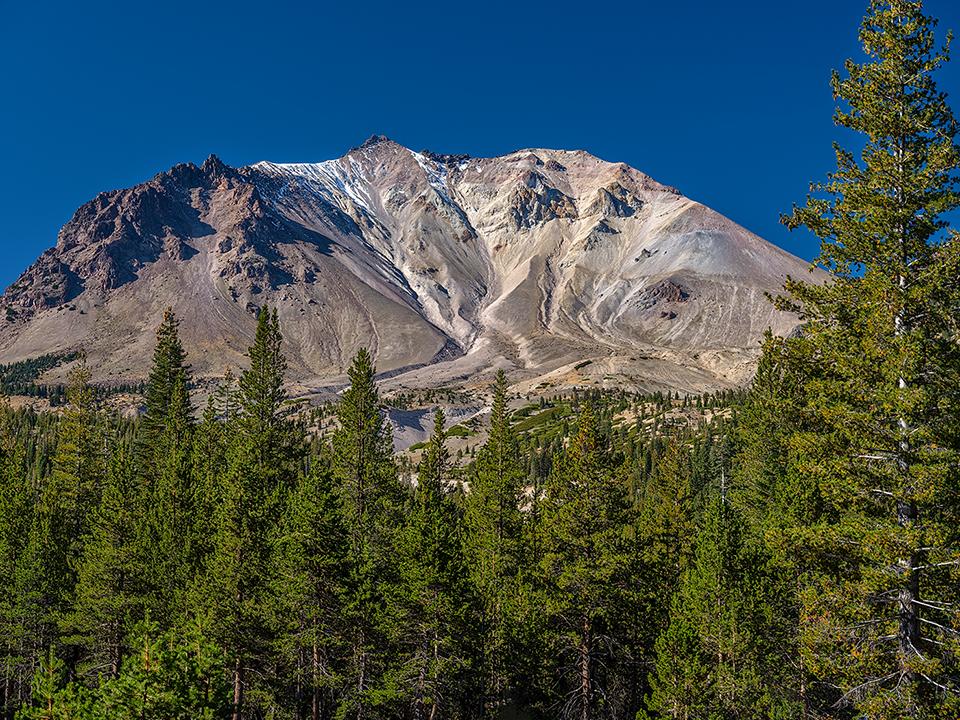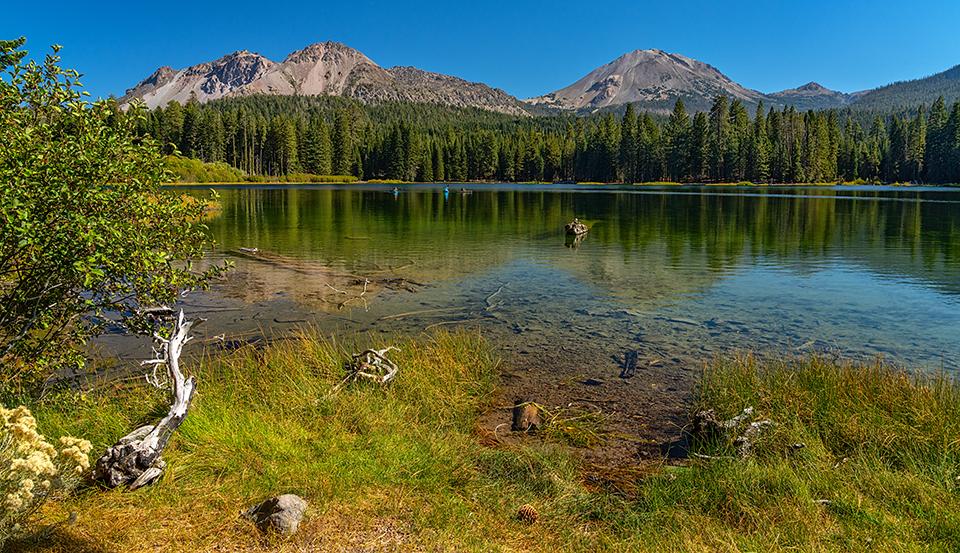
A view of Lassen Peak as seen from the Devastated Area Interpretive Trail, Lassen Volcanic National Park / Rebecca Latson
Thinking about a trip to Lassen Volcanic National Park? You should. If you’ve never visited this national park in California, you might wonder what you can do once you arrive. Maybe you only have a few days to spend – like three days? What can you see and do during that amount of time? Plenty!
Getting There And Staying There
Most of you will probably travel between summer and early fall, flying into airports nearest the park: Redding and Sacramento, California, and Reno, Nevada. From there, you will need to rent a vehicle. Along the way, you might want to stop off at a grocery store to stock up on food items and gallon jugs of water. Make sure the vehicle is gassed up prior to entering Lassen, because there is only one place to purchase gasoline within the park - Manzanita Lake Camper Store - and there’s no guarantee the pumps will be working. Some of the smaller communities outside Lassen have gas, so no need to drive all the way to Redding far west of the park or Susanville far east of the park to top off the tank. For help with logistics and planning, check out the Traveler Checklist for Lassen.
In terms of lodging, there’s anything from a small motel in Mineral, nine miles from the park’s southwestern entrance, and Vrbo and Airbnb options, to Drakesbad Guest Ranch (currently closed for the 2022 season due to the Dixie Fire), to the park’s seven campgrounds, to camping cabins at Manzanita Lake.

Manzanita Lake camping cabin and picnic area, Lassen Volcanic National Park / Rebecca Latson
Check the weather reports often and pack accordingly, including a pair of sturdy hiking boots and your camera, spare batteries, and plenty of memory cards to record the sights. You might want to include one or two adjustable hiking poles in your luggage, too. They help your knees while descending steep trails.
Despite the closures of various facilities and trails due to the 2021 Dixie Fire that burned through 69 percent of Lassen, there’s still plenty to see and do. Following is a suggested itinerary if you only have three days to spend in this park.
Day 1

The winding road through the park, Lassen Volcanic National Park / Rebecca Latson
Pack a picnic lunch and drive the length of the 30-mile-long Lassen Volcanic National Park Highway, stopping at all 16 marker posts along the way. Take your time and drive the posted speed limits. The road is twisting with several U-curves in the upper elevations. Each marker post introduces you to scenic, historical, and geological areas of note. Take along the road guide Lassen Volcanic National Park: Auto Tours, Trips, and Trails by Larry Eifert, or download the NPS App to access 16 audio files corresponding to the tour markers.
You might want to stop and stretch your legs along some of the shorter trails, like the Devastated Area Interpretive Trail, or Sulphur Works located just up the road from Kohm Yah-mah-nee Visitor Center.

A boiling mud pot at Sulphur Works, Lassen Volcanic National Park / Rebecca Latson
Visit the Loomis Museum at Manzanita Lake for visitor information and to learn a bit of park history, then take a leisurely 1.9-mile walk along the trail around the lake. You’ll see all sorts of waterfowl, including Canada geese, blue herons, and ducks. You might also spy deer and most certainly busy little chipmunks and squirrels, including the golden-mantled squirrel. Chaos Crags and Lassen Peak tower over the lake in the background.
While visiting Kohm Yah-mah-nee Visitor Center or Loomis Museum, check to see if there are any ranger-led programs for that day or evening. And speaking of evening, if you are camping out or staying in a Manzanita Lake camping cabin, purchase some firewood and marshmallows and chocolate bars at the camper store to enjoy s’mores while looking up into the vast night sky of sparkling stars unmarred by light pollution.
Day 2

A view of Bumpass Hell from the Frying Pan Trail, Lassen Volcanic National Park / Rebecca Latson
No visit to Lassen is complete without hiking the three-mile-roundtrip Bumpass Hell Trail to the park’s largest hydrothermal area. There’s a great overlook of Bumpass Hell before heading down the trail to the boardwalk. As you hike down from the overlook, you’ll see a sign offering you the choice of taking the Frying Pan Trail to the boardwalk or staying on the Bumpass Hell Trail. Take my advice and choose the Frying Pan Trail option. While both trails lead to the boardwalk, the Frying Pan hike is a little shorter, a little less steep, easier to maneuver, and the views are much nicer.
If you still have energy to burn, continue your hike from Bumpass Hell to Cold Boiling Lake for an extra 1.9 miles one-way before turning around and heading all the way back to the Bumpass Hell parking lot. Cold Boiling Lake is “a ‘dying’ hydrothermal area that continues to emit small amounts of gas bubbles at some points near the shore.”
Of course, if you don’t feel like hiking that extra four miles roundtrip to Cold Boiling Lake from Bumpass Hell, you can drive back up the park road to Kings Creek Picnic Area and take the trailhead for a half-mile hike to the lake (1 mile roundtrip), instead. Return to the picnic area to enjoy lunch before hitting the road again.
Day 3

The trail to the top of Cinder Cone, Lassen Volcanic National Park / Rebecca Latson
Engage in a little workout and hike either the popular five-mile roundtrip Lassen Peak Trail to the summit of the world’s largest plug dome volcano, or the four-mile roundtrip Cinder Cone Trail to the cone’s summit in the more remote northeastern corner of the park. Both are considered strenuous hikes and are exposed to the sun, but the views at the top justify the effort to get there. FYI, while the last 200 feet up Cinder Cone is loose volcanic gravel with a 30- to 35-degree angle of repose, you’ll encounter far fewer people than you will hiking up to Lassen Peak, whose popularity and ease of access mean more crowds along the trail and at the summit. Just take your time with either trail and make sure you’ve packed plenty of water and snacks.
If you don’t feel like tackling either of those hikes, why not spend your last day in the park plying the waters of Manzanita Lake in a kayak (single or double), canoe, or on a paddle board, any of which you can rent at the Manzanita Camper Store for one, two, or four hours.

A lovely autumn afternoon at Manzanita Lake, Lassen Volcanic National Park / Rebecca Latson
With so much to see and do at Lassen, you won’t have a problem choosing what to place on a three-day itinerary. After those three days, you might even decide a future visit is in order for yet another three days’ worth of activities.



Comments
If you plan on backcountry campint- you cant have a fire. I wound up hiking into the woods for 200 yards, setting down my bivy sack and sleeping on the forest floor.
The next day their was SO MANY mosquitos that a bivy sack made no sense and I boogied my way out of the backcountry and into a red bluff hotel. Very cool park though- just come prepared for no fire and be sure to have a tent with a skeeter net.